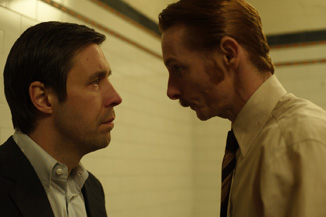|
|
Chapter Two:
|

|
New at BOP: Share & Save
![]() Tweet
Tweet
![]() Print this column
Print this column
The central irony of Grave of the Fireflies is how their hope, their spirits and eventually their bodies (the sister succumbs to malnutrition) are broken down, in the middle of a gorgeous pastoral landscape that would be a child’s summertime play world under ordinary circumstances. It’s a narrative of utter simplicity sketched in stark terms (and at 89 minutes, it bears the intimacy of a short story or novella rather than an epic sprawl) and its thorough success as a film — not simply anime — is in its deft avoidance of sentimentalizing the subject matter, not an easy thing to do when the slow wasting away of a young girl is one of your key themes. Nosaka’s story was also recently adapted into a live action film, but animation strikes me as the most appropriate (perhaps the only appropriate) medium for this tale. The edges seem sharper, the colors seem brighter, and yes, the mounting desperation feels more palpable than it would with “real actors”.
I chose this week’s column with Stieg Larsson’s “Millennium Trilogy” films fresh in my mind. I figured another recent adaptation of a crime fiction series to the big screen would be appropriate, as well as giving me even more novels to eventually work my way around to reading. I opted for one of the most celebrated set of films in recent years, a trio of 2009 productions that, like The Girl with the Dragon Tattoo, et al. made their way to the States in 2010.
|
Advertisement |
The Red Riding series, British novelist David Peace’s quartet of fiction books about a decades-long murder investigation and its dovetailing with unfathomable police corruption in Yorkshire, England came out around the start of last decade and was directly inspired by actual crimes (and cover-ups) in the area. Each book focuses on a different year (1974, 1977, 1980, 1983) and different leading protagonists — a newspaper reporter, a detective, a lawyer — while secondary characters often carry on through, popping up again when least expected, sometimes simply in the background, and sometimes with information or actions that fundamentally alter the story.
Three of the four books were made into films for British television, adapted by the same screenwriter, but helmed by three different directors. (’77 was left out, for purely economic reasons, but a full screenplay exists and the film may yet be made somewhere down the line.) The first film was directed by Julian Jarrold (Kinky Boots, Brideshead Revisited), the second by James Marsh (Man on Wire, The King), and the final installment by Anand Tucker (Shopgirl, Leap Year). Each was also shot on a different film format — 16mm for 1974, 35mm for 1980 and digital for 1983. The films are meant to be standalone and could be watched in that light, but as my discussion below shows, I think that would rob them of what little effective power is gained from watching all three cumulatively over a short period of time.

|
|
|

|
Thursday, May 2, 2024
© 2024 Box Office Prophets, a division of One Of Us, Inc.

